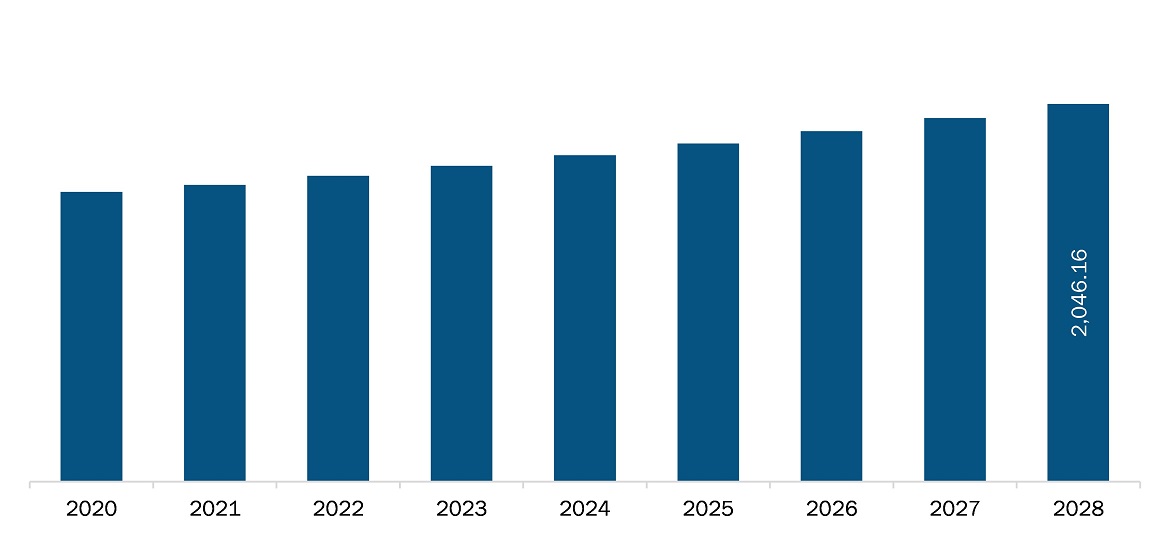The medical imaging market in Middle East and Africa is expected to grow from US$ 1,607.3 million in 2021 to US$ 2,046.2 million by 2028; it is estimated to grow at a CAGR of 3.5% from 2021 to 2028.
Medical imaging is an integral part of the diagnostic process. From ultrasounds to MRIs and CT scans, radiologists utilize medical imaging to properly diagnose and treat diseases. Also, doctors use medical imaging technologies to determine if a particular therapy has been effective in patient’s treatment method. Over the past couple of decades, the capabilities of medical imaging have radially increased. There have been numerous advancements in medical imaging technology owing to essential research and technological evolution. This progress is crucial in providing accurate diagnoses and bettering patient care. These advancements, along with the power of IT and digital technology, promotes greater procedural efficiency in the provision and execution of patient care. Artificial intelligence (AI) helps improve numerous aspects of the healthcare industry, and medical imaging technology is one of the fields that has benefited greatly. AI is being used to make advanced imaging devices, which can detect diseases earlier and guide diagnosis and early treatment.
Countries like UAE and Saudi Arabia have also registered many positive coronavirus infection cases. These regions are developing in terms of the healthcare and medical service industry. The countries in these regions are highly dependent on medical devices imported from developed countries. Therefore, countries have faced several challenges with their requirements for medical imaging systems due to severe disruption in supply chains. Health authorities are worrying that attempting to fight the coronavirus will indirectly contribute to an increase in deaths of ill patients, including cancer patients, gynecology patients, and other causes. The death pool of ill patients in low-cost regions is expected to increase because healthcare professionals are having limited their patients checking as many clinics as possible, diagnostic centers, ambulatory surgery centers have limited resources and staff. However, there has been a spur in demand for imaging modalities such as computed tomography and ultrasound systems to manage the treatment of patients suffering with COVID-19. Countries were severely hit by the pandemic and deployed large number of chests imaging every single day. These factors thus encouraged the growth of the medical imaging market in this region.
With the new features and technologies, vendors can attract new customers and expand their footprints in emerging markets. This factor is likely to drive the medical imaging market. The Middle East and Africa medical imaging market is expected to grow at a good CAGR during the forecast period.

- This FREE sample will include data analysis, ranging from market trends to estimates and forecasts.
Middle East and Africa Medical Imaging Market Segmentation
By Product
- CT Systems
- X-ray Systems
- PET Systems
- MRI systems
- Ultrasound Systems
- Others
By End User
- Hospitals
- OP Centres
- Clinicians Offices
- Emergency Care Centres
By Country
-
Middle East and Africa
- UAE
- Saudi Arabia
- South Africa
- Rest of Middle East and Africa
Companies Mentioned
- General Electric Company
- Siemens AG
- Koninklijke Philips N.V.
- Shimadzu Corporation
- Hitachi, Ltd.
- Canon Inc.
- Hologic, Inc.
- Carestream Health Inc.
- Samsung Group
Middle East and Africa Medical Imaging Report Scope
| Report Attribute | Details |
|---|---|
| Market size in 2021 | US$ 1,607.3 Million |
| Market Size by 2028 | US$ 2,046.2 Million |
| CAGR (2021 - 2028) | 3.5% |
| Historical Data | 2019-2020 |
| Forecast period | 2022-2028 |
| Segments Covered |
By Product
|
| Regions and Countries Covered |
Middle East and Africa
|
| Market leaders and key company profiles |
|
- Historical Analysis (2 Years), Base Year, Forecast (7 Years) with CAGR
- PEST and SWOT Analysis
- Market Size Value / Volume - Regional, Country
- Industry and Competitive Landscape
- Excel Dataset
Recent Reports
Testimonials
Reason to Buy
- Informed Decision-Making
- Understanding Market Dynamics
- Competitive Analysis
- Identifying Emerging Markets
- Customer Insights
- Market Forecasts
- Risk Mitigation
- Boosting Operational Efficiency
- Strategic Planning
- Investment Justification
- Tracking Industry Innovations
- Aligning with Regulatory Trends





















 Get Free Sample For
Get Free Sample For